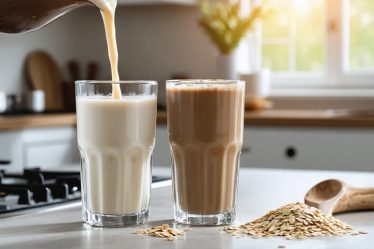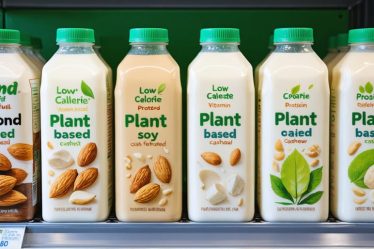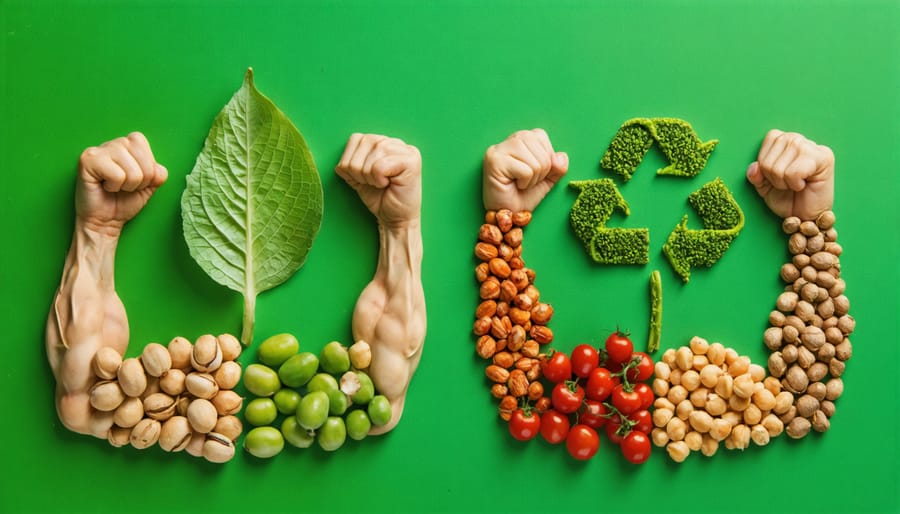
Transform your protein intake with legumes – nature’s nutritional powerhouses that pack more protein per serving than most plant-based foods. Whether you’re exploring plant-based diet options or simply wanting to boost your protein consumption affordably, legumes offer an impressive nutritional profile that rivals animal protein sources.
From mighty soybeans boasting 28.6g of protein per cup to versatile lentils delivering 17.9g per serving, legumes provide an ideal solution for conscious consumers seeking complete protein sources. Beyond their protein content, these pantry staples deliver essential fiber, minerals, and vitamins while remaining budget-friendly and environmentally sustainable.
Let’s explore a comprehensive breakdown of protein content across different legume varieties, helping you make informed choices for your dietary needs. Whether you’re meal planning for your family or optimizing your own nutrition, understanding these protein powerhouses will revolutionize your approach to healthy eating.
Why Legumes Are Your Protein Powerhouse
Remember when everyone thought protein only came from meat? Those days are long gone! As someone who discovered the amazing world of legumes during my journey to eat more plant-based meals, I can tell you these little powerhouses are absolute game-changers for your protein needs.
Legumes are nature’s protein treasure chest, packed with not just protein but also fiber, minerals, and vitamins. What makes them truly special is their impressive protein content – for instance, a single cup of lentils provides about 18 grams of protein, which is roughly the same as three eggs!
But here’s what I love most about legumes: they’re incredibly versatile and budget-friendly. Whether you’re whipping up a creamy chickpea curry, tossing black beans into your favorite salad, or making a hearty lentil soup, these protein-rich gems can transform any meal into a nutritious feast.
For my fellow health-conscious friends, legumes offer something unique: they’re one of the few plant foods that provide nearly complete protein profiles. When paired with whole grains, they create a perfect protein combination that rivals animal sources. Plus, they’re cholesterol-free and naturally low in fat, making them an excellent choice for heart-healthy eating.
Trust me, once you start exploring the world of legumes, you’ll wonder why they weren’t always the star of your plate!
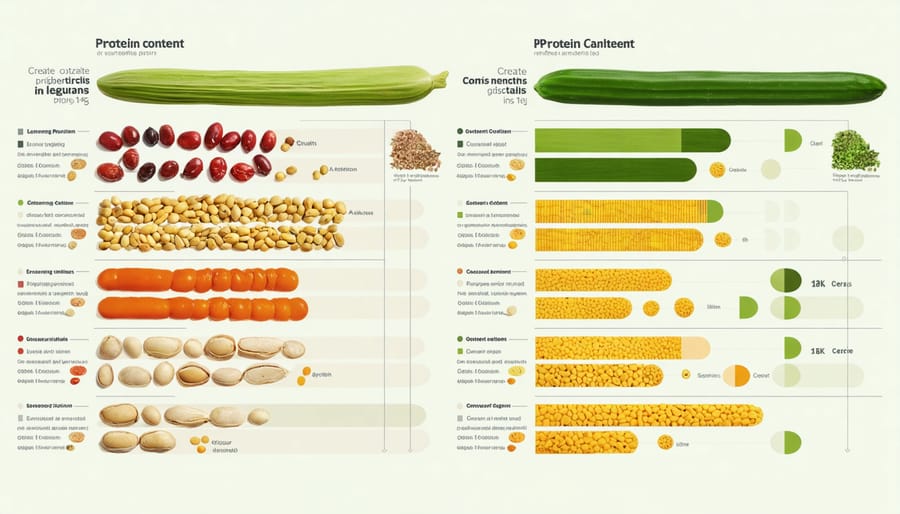
Your Complete Legume Protein Chart
High-Protein Champions
When it comes to protein powerhouses in the legume family, three champions stand out from the crowd. Soybeans take the crown with an impressive 28.6 grams of protein per cup, making them an excellent choice for anyone looking to boost their protein intake. I discovered this gem while experimenting with homemade tofu, and it’s been a game-changer in my kitchen ever since!
Coming in strong at second place are lentils, packing about 18 grams of protein per cup. These tiny nutritional dynamos are incredibly versatile – whether you’re whipping up a warming dal or adding them to your favorite soup, they’re a protein-rich addition that doesn’t overwhelm other flavors.
Kidney beans round out our top three with approximately 15 grams of protein per cup. They’re my go-to for hearty chilis and vibrant salads, offering that perfect combination of protein punch and satisfying texture. What I love most about these protein champions is how easily they fit into everyday cooking – no fancy techniques required!
Remember, these protein stars are also loaded with fiber, minerals, and other nutrients, making them true nutritional multitaskers in your pantry.
Middle-Range Heroes
When it comes to moderate-protein legumes, these versatile powerhouses are my go-to choices for everyday meals. Chickpeas, black beans, and peas pack a respectable protein punch while offering incredible versatility in the kitchen. With about 15 grams of protein per cup, chickpeas are perfect for whipping up creamy hummus or adding a satisfying crunch to salads. I’ve found that roasting them with a bit of olive oil and spices makes for an addictive healthy snack!
Black beans are another fantastic middle-range option, providing roughly 15.2 grams of protein per cup. These kitchen heroes shine in everything from vegetarian tacos to hearty soups. Fun fact: I’ve even used them to make brownies, and my friends couldn’t believe they were packed with protein!
Green peas might surprise you with their protein content – about 8.6 grams per cup. They’re perfect for adding a pop of color and nutrition to rice dishes, pasta, or even as a simple side. Plus, they’re usually a hit with picky eaters, making them a family-friendly choice. These moderate-protein legumes are especially great for those just starting to explore plant-based protein sources, as they’re mild in flavor and easy to incorporate into familiar dishes.
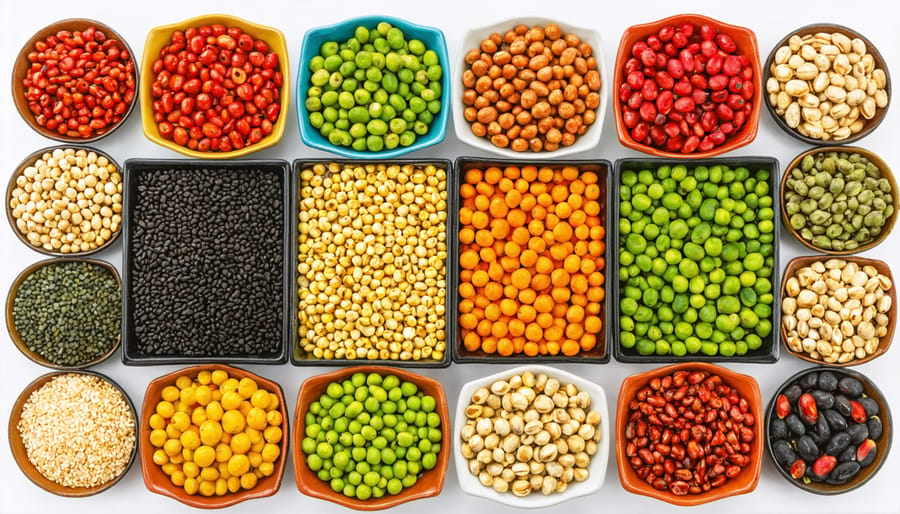
Making Legumes Work in Your Kitchen
Quick-Prep Methods
Short on time but still want to enjoy nutritious legumes? I’ve got you covered with these game-changing meal prep tips that’ll transform how you prepare these protein powerhouses.
First up, try the overnight soak-and-cook method: Before bed, rinse your legumes and cover them with water. By morning, they’ll be ready for a quick cook. For even faster results, use the quick-soak technique: Bring legumes to a boil for 2-3 minutes, then let them sit for an hour.
My personal favorite is using canned legumes – they’re pre-cooked and ready to go! Just rinse them well under cold water to reduce sodium content. For lentils and split peas, you can skip soaking altogether; they cook up in just 20-30 minutes.
Keep a variety of prepared legumes in your freezer. After cooking, portion them into freezer bags – they’ll stay fresh for up to six months. When needed, just thaw and add to your favorite recipes!

Perfect Pairings
Creating complete proteins doesn’t have to be complicated! While legumes are protein powerhouses, combining them with complementary foods can help you transform your meals into perfect protein packages. Think of it as matchmaking for your ingredients!
Try these delicious combinations:
• Lentils + brown rice (perfect in a warming Buddha bowl)
• Black beans + corn tortillas (hello, taco Tuesday!)
• Chickpeas + whole wheat pita (homemade hummus heaven)
• Split peas + quinoa (hearty soup season essential)
• Kidney beans + brown rice (classic rice and beans got it right!)
These pairings aren’t just nutritionally smart – they’re also deeply rooted in traditional cuisines worldwide. From Indian dal with rice to Mediterranean hummus with pita, cultures have intuitively known these combinations work magic together. The best part? These pairings are incredibly versatile and can be adapted to suit any taste preference or dietary need. Keep these combos in mind next time you’re meal planning, and you’ll be serving up complete protein goodness with every bite!
Simple Ways to Boost Your Legume Game
Let me share a little secret from my kitchen adventures: transforming legumes from basic pantry staples into crave-worthy meals is easier than you might think! I’ve discovered some game-changing strategies that have made legumes a daily highlight in my household.
First, try the “blend and extend” method – mix pureed lentils into your favorite pasta sauce or add mashed black beans to burger patties. It’s a brilliant way to boost protein while keeping familiar flavors. Speaking of familiar, chickpeas can be your new best friend in the kitchen. Roast them with your favorite seasonings for a crunchy snack, or blend them into a creamy hummus with unexpected add-ins like roasted red peppers or fresh herbs.
Make meal prep your ally by cooking a big batch of legumes on Sunday. Store them in portion-sized containers, and you’ll have ready-to-use protein for quick lunches and dinners all week. Try adding white beans to your morning smoothie (trust me, you won’t taste them!), or toss some lentils into your salad for an instant protein boost.
For the busy days, keep canned legumes on hand – they’re perfectly fine! Just remember to rinse them well. One of my favorite weeknight tricks is creating a “bean bar” where everyone can customize their bowls with different legumes, grains, and toppings.
Don’t forget about snacks! Edamame makes a perfect afternoon pick-me-up, and roasted fava beans can satisfy those crunchy cravings. The key is to start small and experiment until you find combinations that work for your taste buds and lifestyle.
As we’ve discovered, legumes are true nutritional powerhouses that deserve a prime spot on your plate. Not only are they packed with protein, but they’re also budget-friendly and incredibly versatile. Whether you prefer the creamy texture of chickpeas, the earthy flavor of lentils, or the classic comfort of black beans, there’s a legume out there for everyone.
Remember, incorporating legumes into your diet doesn’t have to be complicated. Start small by adding a handful of beans to your favorite salad or trying a lentil-based soup. Your body will thank you for the protein boost, and your taste buds will be pleasantly surprised by the delicious possibilities.
So why not challenge yourself to try a new legume variety this week? With their impressive protein content and endless cooking options, legumes are the perfect addition to any healthy lifestyle. Your journey to better nutrition starts with these humble yet mighty plant-based proteins!


